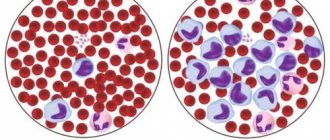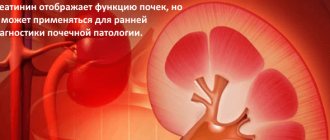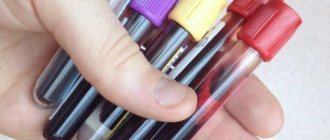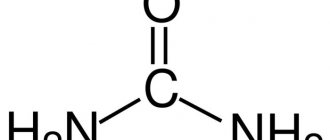Role and types of leukocytes
Previously, blood cells were divided into only two types: red blood cells (red) and white blood cells (white). Red cells supply oxygen to tissues, and white cells provide protection to the human body. Then scientists discovered that leukocytes differ in type and purpose. However, all existing types protect the body from:
- foreign objects - viruses, pathogenic bacteria, pathogenic microorganisms;
- parasites;
- waste products of body tissues;
- harmful mutated tissue structures.
White blood cells ensure high-quality cell regeneration and maintain normal homeostasis. There are many more red blood cells in human blood than white blood cells, which is why it is colored red.
White blood cells have the ability to penetrate the walls of capillaries and enter the affected areas. They neutralize the harmful effects and normalize the functioning of the body. According to their structure, leukocytes are divided into two types:
- Granulocytes are characterized by their large size and granular structure. This variety is divided into neutrophils, eosinophils and basophils.
- Agranulocytes are small cells with a non-granular structure. Includes lymphocytes and monocytes.
Monocytes are formed in the red bone marrow, lymphocytes appear there, but reproduce in the spleen, lymph nodes and tonsils. All types of white blood cells play a vital role:
- lymphocytes are responsible for immunity;
- basophils protect the body from the influence of allergens;
- neutrophils have the ability to phagocytose - counteract toxins and pathogens;
- monocytes fight against viruses, microbes and parasites;
- eosinophils protect against the formation of malignant cells and prevent the development of allergies.
Norm by age for children
To monitor the health of the younger generation, parents should familiarize themselves with the table of the norm of leukocytes in the child’s blood. By deciphering the leukocyte formula, you can find out about the state of the baby’s immunity and detect pathological changes in time.
Doctors require not only information about the total concentration of leukocytes, but also information about the ratio of their varieties. From these data the leukocyte formula is compiled. White blood cells are designated by the letters WBC and are measured in billions per liter of blood.
In infants, the level of leukocytes in the blood is much higher than in an adult. This happens because the newborn’s body is very sensitive to non-sterile conditions, and it requires enhanced protection against pathogenic microbes. With age, the number of white cells decreases.
Normal values for infants are 10−25 x 109/l, for babies up to 12 months—9−15 x 109/l, similar values are optimal until children reach the age of three. As you grow older, the levels will be 6−11 x 109/l.
Of course, these are approximate values; the norm of leukocytes in children depends on the individual characteristics of the body. In adolescence, the number of white cells approaches the norm for adults - 4.2−10.5.
Causes of leukopenia
The number of colorless cells most often decreases against the background of progressive pathological changes in the body. Low leukocytes in a child’s blood accompany the following diseases:
A decrease in neutrophils in the blood of a child
- cyanocobalamin-deficiency anemia - anemia associated with insufficient supply of the body with vitamin B12 (cyanocobalamin);
- anaplastic anemia is a type of hypoplastic anemia characterized by a defect in stem cells;
- heavy metal poisoning;
- autoimmune pathologies in which antigens are produced by the body’s own immune system (ankylosing spondylitis, rheumatoid arthritis, Crohn’s disease, systemic lupus erythematosus, etc.);
- HIV and AIDS (in infants inherited from an infected mother);
- juvenile diabetes mellitus type 1;
- hypothyroidism – low level of thyroid hormone production;
- so-called childhood viral infections (measles, rubella, chickenpox, mumps, etc.);
- infection with herpes viruses type 4 and 5 (cytomegalovirus, Epstein-Barr virus, otherwise infectious mononucleosis);
- viral hepatitis A, B, C;
- ARVI;
- bone marrow diseases associated with dysfunction of the production of blood cells;
- a malignant tumor that suppresses normal hematopoiesis (myeloma).
A reduced number of leukocyte cells is a consequence of anaphylactic shock (an acute allergic reaction of an immediate type) and cachexia (exhaustion of the body). Non-pathological reasons for decreased performance:
- rehabilitation period after childhood viral diseases;
- postoperative period after surgery and long-term immobilization (immobility);
- nervous shock suffered by the child;
- unbalanced menu (deficiency of B-group vitamins in the diet).
A reduced level of leukocytes may be a consequence of incorrect therapy with sulfonamide, antiviral, antitumor, and painkillers.
Additional information about leukocyte formula values
The parameters of all varieties of colorless cells are in close correlation. When assessing WBC results, other leukogram indicators must be taken into account. Of particular importance is neutropenia (low neutrophil count), which accompanies:
- zoonotic infections (brucellosis, tularemia, typhoid fever);
- parasitic infections of Toxoplasma and Plasmodium (toxoplasmosis and malaria);
- bone marrow suppression after chemotherapy or radiation exposure (radiation sickness).
Chronic neutropenia can be a hereditary feature - Kostmann's syndrome (genetic inability of young neutrophils to mature). Monocytopenia (monocyte counts below normal) is characteristic of streptococcal infections.
Eosinopenia (eosinophil deficiency) is characteristic of long-term purulent-inflammatory processes. Lymphopenia (decreased lymphocytes) is recorded in oncopathologies (blood cancers).
Reasons for deviations from the optimal level
The leukocyte formula allows not only to detect the presence of the disease, but also to identify its cause and form, and find out the further prognosis. A slight increase in the number of white bodies may indicate a mild form of the disease. With a long-term infectious disease, it is necessary to intensively use leukocytes, so their concentration decreases.
This is the most common reason for a decrease in performance levels. There are two types of deviations from the norm:
- leukocytosis - exceeding the normal level;
- Leukopenia is a lack of white blood cells.
Both indicate the presence of pathological processes in the body. If the level of leukocytes in the blood of children deviates from the norm, you should consult a doctor.
Leukocyte formula and its changes
In the diagnostic process, doctors pay attention to the excess of the norm of leukocytes in the blood of children, to the ratio of different types of leukocyte cells. To determine which infection caused the pathology, the specialist must evaluate the change in concentration in the leukocyte formula.
Leukocytes are divided into several types: neutrophils, eosinophils, monocytes, lymphocytes and basophils. They are united by the presence of a nucleus and the absence of their own color. Each type of white blood cell plays a specific role in the human immune system:
- Neutrophils form the bulk of leukocytes. Their main function is to find and destroy infections and bacteria.
- Basophils participate in the formation of inflammatory reactions, which attracts immune cells to the lesion. Exchange information between them.
- Eosinophils are an important link in the development of the body's allergic response.
- Monocytes regulate the immune response and promote the restoration of skin and nerve fibers.
- Lymphocytes organize the fight against bacteria and viruses and tumor cells.
By observing an increase in the concentration of one of them, conclusions can be drawn regarding the disease that served as the root cause of the pathology. For example: if a baby’s test results show an excess of leukocytes and eosinophils in the blood, then the likely reason for this is the presence of worms and allergic reactions in the body. This disease is called “eosinophilia”.
If, against the background of high leukocytes, a child has elevated monocytes, then the disease is called monocytosis, and the efforts of doctors are aimed at excluding the diagnosis of mononucleosis.
In newborns and up to 4-5 years of age, an increase in white blood cells occurs frequently. And this is not always a signal about the presence of health problems. Additional examination will be needed in a situation where an excess of leukocytes in the blood is accompanied by the following symptoms:
- increased body temperature,
- painful sensations in joints and muscles,
- constant feeling of fatigue,
- occasional dizziness,
- deterioration in sleep quality and loss of appetite,
- sometimes increased sweating.
Increased performance
Diagnosing leukocytosis is a sure sign of the presence of inflammatory processes. With any virus, the number of white cells increases. Leukocytosis can be caused by the following diseases:
- respiratory viral diseases, influenza;
- otitis media, sore throat;
- bronchitis, pneumonia;
- purulent inflammation;
- chicken pox.
White cell levels may also increase with oral inflammation, diarrhea, injury, and burns. When infected with worms, an increase in the number of eosinophils is observed. Leukocytosis may indicate malignant blood diseases. This disorder is called leukemia. However, in some cases, an increase in the number of white blood cells is a natural condition after:
- stress;
- vaccinations;
- intense physical activity;
- food abuse.
If the increase in indicators was diagnosed once, there is no need to worry. However, if there are other abnormalities in the blood test and the child’s condition worsens, the doctor must determine the cause of the abnormalities. In such cases, the small patient needs proper therapy.
White cell deficiency
Leukopenia is much less common than leukocytosis, and also indicates the presence of problems in the body. A deficiency indicates that the immune system is not working properly and is not producing enough blood cells. In addition, leukopenia can be diagnosed in the following conditions:
- genetic diseases;
- blood or bone marrow pathologies;
- radiation sickness;
- presence of allergic reactions;
- regularly taking certain medications;
- poisoning;
- viral infections, such as influenza.
Low white blood cells in a child's blood
Parents are often interested in the answer to the question - what can the result of a blood test indicate, in which the child has low white blood cells (leukopenia). Factors causing the condition of leukopenia include:
- pathologies in the functioning of the bone marrow, as a result of which a sufficient number of blood cells are not formed. Malignant tissue lesions or a lack of vitamins, as well as macro- and microelements, can lead to such malfunctions. In addition, bone marrow destruction is possible due to chemical (drugs) or ionizing effects on humans;
- chronic viral hepatitis;
- leukemia is a malignant lesion of blood cells;
- Rustitsky-Kahler disease – malignant tumors of B-lymphocytes;
- megaloblastic anemia - develops when there is insufficient vitamin B12 in the body, resulting in malfunctions in the bone marrow and nervous system;
- anaphylaxis is an immediate allergic reaction in response to an allergic agent;
- myelodysplastic syndrome, despite the fact that it is extremely rare in children, nevertheless, it is unacceptable to exclude it from the list of possible causes. A characteristic difference is the absence of a typical clinical picture. The condition is characterized by a deficiency of one or more types of blood cells.
Signs of leukopenia and leukocytosis
Leukocytosis and leukopenia are not specific diseases, but symptoms indicating the presence of diseases. In the first case, the condition is asymptomatic; the following signs will indicate a problem:
- decreased appetite and weight loss;
- fever;
- increased body temperature;
- lethargy, fatigue;
- dizziness;
- increased sweating;
- sleep disturbance;
- fainting conditions;
- enlarged liver, lymph nodes, spleen;
- pain in joints and muscles.
Leukopenia itself also does not have any symptoms. But since this disorder involves the addition of an infectious agent, headaches, tachycardia, and swollen lymph nodes may occur. Therefore, parents should regularly check the normal level of leukocytes in their children’s blood.
Causes and symptoms of elevated
The leukocyte norm in children may be exceeded. This condition indicates the presence of inflammatory processes in the body. An increased concentration of blood cells is called leukocytosis. Can occur at any age (in a 6-month-old, one-year-old child, 2 years and older) due to:
- acute viral respiratory diseases;
- bronchitis;
- pneumonia;
- tonsillitis;
- otitis media;
- long-term use of hormonal drugs, as well as drugs that stimulate the immune system;
- autoimmune pathologies;
- development of oncological tumors;
- purulent processes;
- chickenpox, the level is especially high during the recovery period;
- the body's response to vaccination.
Important information: What do increased segmented or band neutrophils in the child’s blood indicate?
Elevated leukocytes are accompanied by various injuries, burns, inflammatory processes in the oral cavity, and infectious diseases of the genitourinary system. The leukocyte formula should correspond to the norm in children by age.
The greater the deviation of these indicators from the norm, the more intense the inflammatory disease.
An increase in the concentration of leukocyte cells can be physiological and normal. A slight increase in values within three units can be observed during the day due to overeating if the child is overtired after physical activity. If there is an increased level of leukocytes in the blood of a newborn or the blood of a 6-year-old child, the following symptomatic picture will be present:
- decreased appetite or complete refusal of food;
- fever;
- weakness and drowsiness;
- increased sweating;
- sleep disturbance;
- aches and pain in muscles.
Children may experience other symptoms depending on how high the white blood cell count is and what causes the leukocytosis. Fainting, bleeding, attacks of dizziness, and an increase in the size of internal organs - the spleen, liver, lymph nodes - are possible.
By 2-3 years, when the child can already explain what hurts, parents and doctors can conclude where the inflammation occurred, for example, with sore throat or cystitis. With younger children the situation is different. If the body temperature rises, the pediatrician will immediately give a referral for a blood test to determine the number of leukocytes to determine the presence of an inflammatory process.
Decoding the formula
The number of leukocytes directly depends on the age of the child. For a one-year-old baby the following indicators are normal (in%):
- total white blood cells - 6−12;
- neutrophils - 0.5−4;
- basophils - 0−1;
- eosinophils - 0.5−7;
- monocytes - 2−12;
- lymphocytes - 38−72.
An increase in the number of neutrophils in the blood indicates the entry of pathogenic components into the body. This indicates that the body is actively fighting the infection. In addition, the level of neutrophils exceeds the permissible norm in the presence of cancer of the bone marrow, acute pancreatitis, and burns.
Lymphocytes are very sensitive to viruses entering the body. Their number increases with:
- chicken pox;
- cytomegalovirus;
- rubella.
The number of lymphocytes increases in the presence of cancer, when the immune system is trying with all its might to eliminate mutating cells. The number of monocytes in the blood increases when:
- acute infections;
- cancer of the lymph nodes, red bone marrow, stomach, ovaries;
- connective tissue pathologies;
- lung diseases.
The number of eosinophils increases when exposed to allergens, which can provoke allergic shock. Sometimes these components increase when infected with parasites. The number of basophils increases extremely rarely; this can happen due to allergies or cancer.
Necessary tests
The number of leukocytes can be determined by taking a general blood test. If the result obtained is not normal, the doctor prescribes:
- peripheral blood smear examination;
- complete blood test.
The listed tests are necessary to identify the number of eosinophils, monocytes, and basophils. If cancer is suspected, a biopsy of the lymph nodes, spleen, bone marrow, and liver structures is taken.
The baby's first blood test is done 2-3 days after he is born. Afterwards, blood is taken at 3 months and one year of age. Doctors recommend donating blood annually until the age of 6. This is necessary to prevent various diseases, even if the baby is healthy. This reveals:
- level of red blood cells, platelets;
- hemoglobin indicators;
- hematocrit number;
- blood clotting rate.
Blood is drawn from a vein or finger. In infants, biological material for analysis is taken from the heel.
Preparation for the procedure
The level of leukocytes in the blood depends not only on age, but also on the time of day, diet, and the condition of the body as a whole. After eating, the number of white cells increases. Therefore, it is necessary to properly prepare for the analysis:
- Blood must be donated strictly on an empty stomach. The child should not eat for 8 hours before donating blood. Newborns are tested 2 hours after feeding.
- Before donating blood, you should not overexert yourself. It is best to arrive at the hospital early so that your child can sit, rest and relax.
- You should reassure the baby, as even excitement and worries can affect the results of the analysis.
When and how to get tested
To count blood cells in a child’s blood, venous or capillary blood is taken as the biological material to be studied. To calculate the concentration of leukocytes in newborns, blood is taken through a puncture in the heel, in infants - from a finger, in children from 4 to 5 years old - from a vein (on the elbow).
To determine the concentration of leukocytes in a child, a blood test is taken. Indications for its implementation:
- a febrile state, the cause of which cannot be determined;
- the need to make a diagnosis with determination of the exact type of pathogenic microflora;
- the presence of signs indicating parasitic infections;
- leukemia;
- disorders of the immune system.
In order for the analysis to be carried out correctly, the number of leukocytes is calculated correctly, the recommendations regarding preparation for it must be followed:
- Blood is donated only in the morning, and the less time passes between waking up and donating blood, the better.
- It is necessary to take the test only on an empty stomach. It is best if there is an 8-hour break between collection and meal, but in this case the age of the child must be taken into account. The food restriction rule applies to adolescents and school-age children.
- Not only food intake, but also physical activity and the emotional state of the child can affect the level of leukocytes, causing their increase. Therefore, immediately before the study, it is necessary to limit his movement, do not allow him to run, jump, or make other active movements, so that the concentration of leukocytes in the blood does not increase. You definitely need to set yourself up mentally so that the child is not too scared.
The cause of a false result may be a temperature difference. You shouldn’t go into the office immediately after going outside and get tested; you need to sit in a warm room for at least 5-10 minutes to acclimatize. If at the time of the study the child is taking any medications for medical reasons, the doctor must be informed about this.
Important information: The norm of red blood cells in the blood of women (table by age)
Test results are ready on the same day or the next.
Correction of violations
A change in indicators indicates the presence of harmful processes in the child’s body. To choose the right therapy, it is necessary to identify the disease that led to the disturbance in the level of leukocytes. The doctor will do this when the test results are received. In general, the following recommendations are relevant:
- With leukocytosis. If an inflammatory process has been diagnosed, anti-inflammatory drugs are prescribed. For allergies, take antihistamines; if there is an infection, take antibacterial medications. Leukocytosis that appears against the background of skin lesions is treated with antimicrobial ointments. Therapy is prescribed by the attending physician. If tumors are detected, additional diagnostics and tests will be required. Regular consumption of foods high in protein can cause an increase in the number of white blood cells. In such a situation, leukocytosis appears against the background of dysfunction of the spleen or liver. To recover, you will need to adhere to a special diet, eliminating salty, spicy, fried and fatty foods from your diet.
- For leukopenia. To increase white cell levels, you should change your child's diet. It is necessary to include more zinc, potassium, vitamins C and E in the menu. It is very important to get enough Omega-3 acids, which are present in nuts and salmon. It is healthy to eat turkey, chicken, spinach and cabbage; they contain large amounts of vitamin E and zinc. To directly increase the number of leukocytes, you should consume: eggs, plant products, lean white meat, cod liver, seafood, various types of red fish, dairy products.
It is very important for parents to conduct blood tests in children in a timely manner to monitor the white blood cell count. If violations are detected early, the cause of the discrepancy in indicators can be immediately determined and treatment can begin. This will keep your baby in good health and avoid serious problems.
What to do in case of deviations
Any deviation of leukocytes from normal values (up or down) requires diagnostics to clarify the causes of this condition with further prescription of treatment.
How to reduce
In the presence of infectious diseases, anti-inflammatory drugs and antibacterial drugs are prescribed. If the increase is caused by allergic reactions, additional tests are taken to determine the irritating substance (allergen). Antihistamines are prescribed to relieve symptoms.
Important information: What do low eosinophils in an adult indicate in a blood test?
If the increase in the concentration of cells occurs as a result of damage to the skin, the use of topical antimicrobial drugs is prescribed. The choice of one or another medication is made by the doctor individually in each clinical case.
If there are no obvious reasons leading to an increase in white blood cells, perhaps the diet is incorrectly selected, which is dominated by foods high in protein, which is why the liver and spleen are under excessive stress. In this case, it is necessary to exclude fried and fatty foods, salty foods, marinades, and spicy foods from the menu.
How to increase
If the number of leukocytes is insufficient, the child is examined to identify possible reasons for this. If no obvious pathologies are detected, the child will be periodically examined by a doctor and a blood test will be prescribed.
You can increase the number of leukocytes by adjusting your diet. The diet should include foods enriched with potassium, vitamins E and C, and zinc. Particular attention should be paid to products high in omega-3 acids; they are present in sufficient quantities in walnuts and red fish. Omega-3 acids protect cells from pathogenic microflora.
To compensate for the lack of vitamin E, you need to introduce cabbage and spinach, turkey and chicken meat into your diet. These products are enriched with essential substances that protect cells and restore their functioning. If the concentration of leukocytes is low, the menu should regularly include:
- eggs;
- Cod liver;
- lean white meat;
- seafood;
- red fish;
- fermented milk products.
If the diet helps normalize the level of white cells, in the future you will need to periodically donate blood for testing to monitor this indicator.











